How to Buy a Mess Kit and Camp Cooking Gear
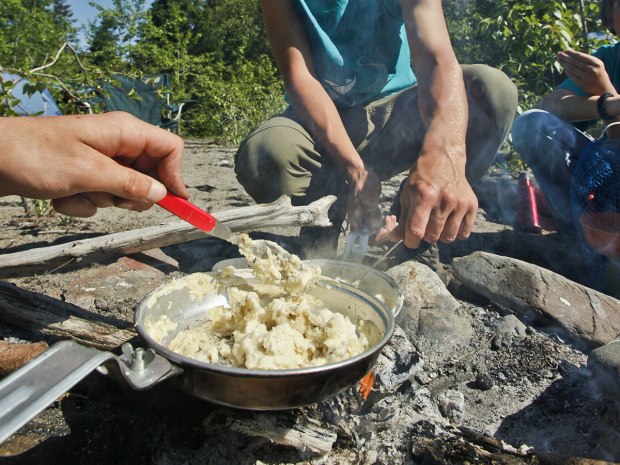
Chow time is one of our favorite things about camping. Whether it’s a steamy pot of cheesy pasta or warm biscuits fresh out of the Dutch oven, good food makes for good times on the trail. Proper nutrition is key when you’re hiking and spending time in the outdoors because it nourishes your body and your spirits. But cooking takes a little work and the right kind of gear.
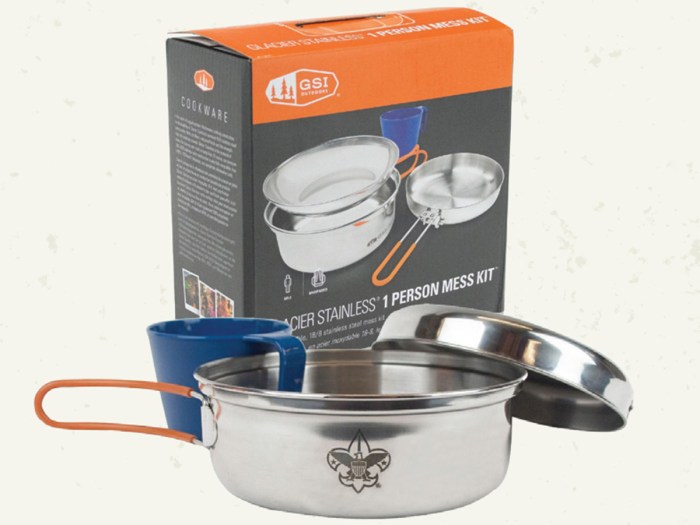
Just try to damage the BSA STAINLESS STEEL MESS KIT ($19.95, scoutshop.org) — it’s not likely. This durable kit comes with everything you need. It’s made from 18/8 stainless steel with a rustproof finish. The set includes a 1-liter pot, 6.3-inch frying pan, 5.9-inch plate and 12-ounce cup. The pot and pan have folding silicone-coated handles, and all the pieces nest together and fit in a mesh stuff sack. Coolest feature: You can use them cooking over a campfire or coals, and the pan can double as a pot lid. 1 lb. 1 oz.
MESS KITS
The term “mess kit” might seem old-fashioned. (Brief history lesson: “Mess” originally referred to a portion of food. As long ago as the 15th century, “mess” also meant a group of four people who sat to eat together.) Today’s camping and backpacking kits for cooking and eating offer a functional, neat modernization for a piece of timeless gear.
Often, the pieces (a cook pot, bowl, cup, etc.) nest together in a compact package that fits easily inside a backpack. These packages are generally lighter weight and more affordable than buying each piece individually. And with a mess kit, before each trip you can pick and choose exactly which pieces of the kit you want/need on the trail. Expect to pay from $10 to $30 for a basic kit.
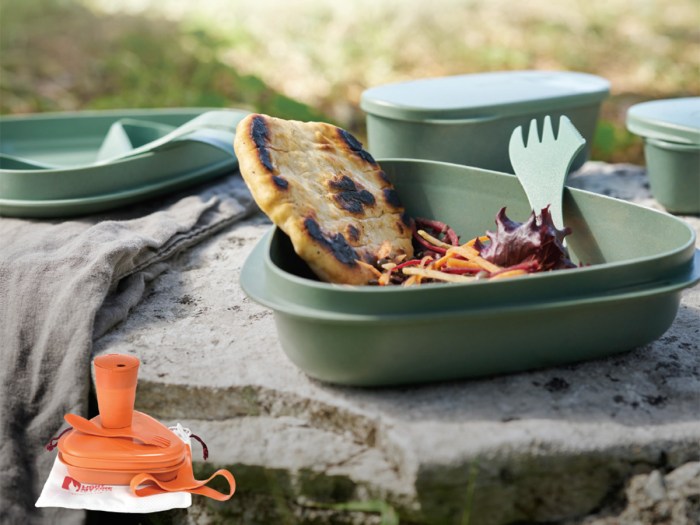
Want a mess kit that’s environmentally less messy? The LIGHT MY FIRE MESSKIT BIO ($24.95, lightmyfire.com) is made from reusable bio-based plastics. It includes a plate, deep-bottomed bowl, collapsible cup and serrated spork. Everything nests, and the kit serves as a lunchbox. 7.2-by-3.5-by-2.3 inches, 9.1 oz.
BOWLS, SPOONS, CUPS
The bare minimum you need for eating on most outings is a bowl, a spoon and a cup. An unbreakable bowl works well for everything you’ll eat, and a spoon (or spork) will help you shovel almost anything into your face.
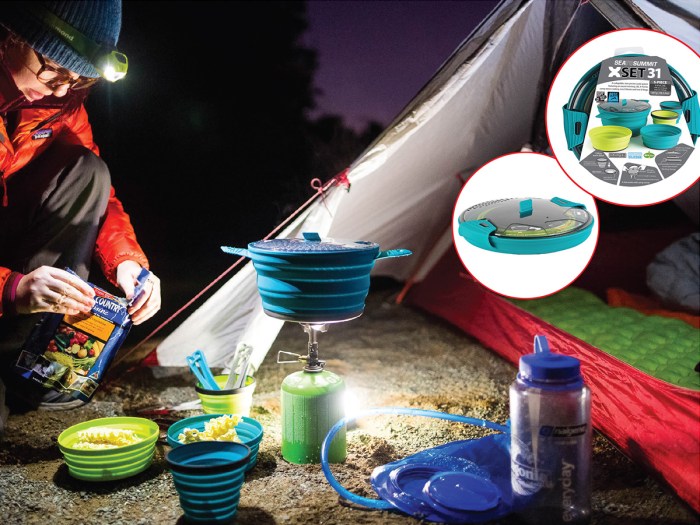
Arguably the coolest innovation in backpacking cook kits in years, the SEA TO SUMMIT X-SET 31 ($109.95, seatosummitusa.com) features a 2.8-liter pot, two 22-ounce bowls and two 16.2-ounce mugs, all of which have flexible, food-grade silicone walls that collapse. The entire nested kit measures about an inch and a half tall. The collapsible walls on the pot, bowls and mugs are rigid when assembled, avoiding spills. The mug walls have measurement markings. The pot’s aluminum base cooks evenly. Bowls, mugs and a collapsible pour-over coffee dripper can be purchased separately and nested into the larger kit or carried individually when backpacking. 1 lb. 5 oz.
STOVES
It’s not always best or even possible to cook by campfire. Open fires might be prohibited where you’re camping, maybe dry firewood is nowhere to be found, or perhaps you just want to have less impact on Mother Earth. That’s where backpacking stoves come in.
We recommend two basic kinds:
Canister (or cartridge) stoves: Small, lightweight and affordable stoves that screw onto canisters of pressurized gas (about $3 each). They’re easy to use and pretty much maintenance-free, but empty canisters aren’t refillable or recyclable and must be packed out.
Liquid-fuel stoves: Compact stoves that use refillable fuel bottles usually containing white gas or propane. They are extremely reliable and work well even in frigid temperatures. Liquid-fuel stoves are generally more expensive, slightly more complicated, and require regular maintenance and cleaning. But they’re also easier on the planet (and, eventually, your wallet) because the fuel bottles are refillable.
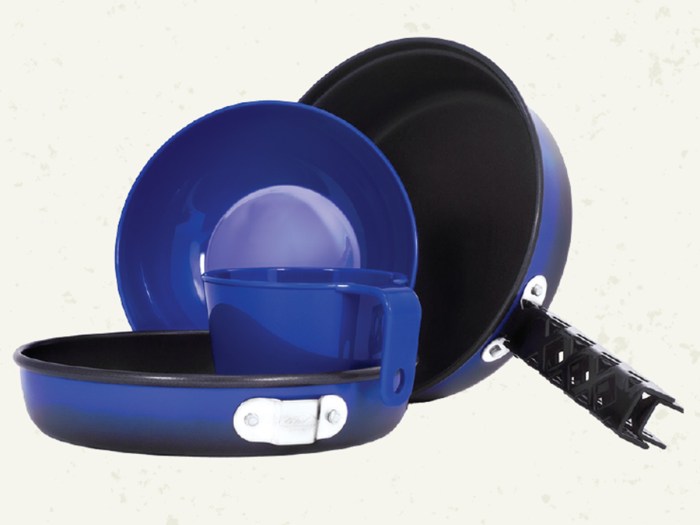
The GSI BUGABOO MESS KIT ($29.99, gsioutdoors.com) provides the implements for cooking and eating: a 1-quart pot, 7.5-inch pan, 6-inch polypropylene bowl, 12-ounce polypropylene cup and a gripper — all nest and stow in a mesh stuff sack. The kit’s aluminum disperses heat to cook evenly, and each piece has two layers of nonstick coating for scratch resistance. In all, a good value for a young camper, if a bit heavy for backpacking. 1 lb. 0.7 oz.
COOK POTS
On most outings, pots and pans are shared to save both weight and money. Pots can be made of everything from sturdy stainless steel to aluminum and super-light titanium. Stainless steel is the most durable and heaviest; aluminum is affordable and lightweight but not so durable; and titanium cookware is durable and super-light but very expensive. Prices range from $15 to $100, and some come with a nonstick coating. Always look for a pot that comes with a lid, because it speeds up boiling times and often can be flipped over and used as a frying pan.
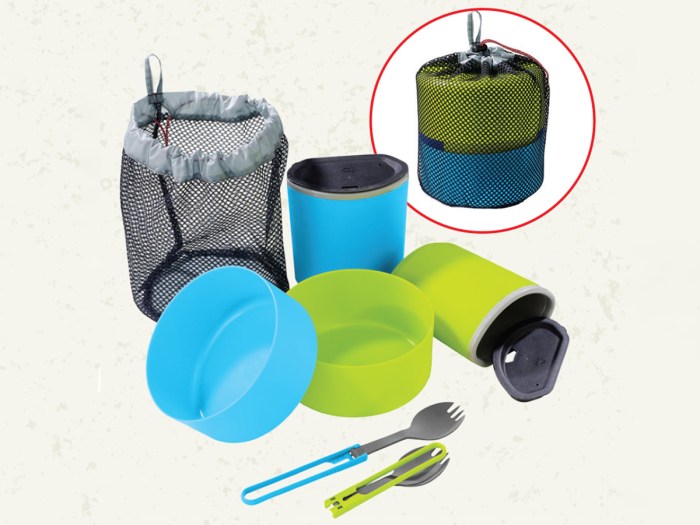
For two hungry campers, the MSR 2-PERSON MESS KIT ($34.95, msrgear.com) offers a simple lightweight kit: two plastic insulated mugs, two deep dish bowls and two folding sporks. The components nest and store in a mesh bag, measuring just more than 5-by-5 inches, making the kit ideal for backpacking. 13 oz.
DUTCH OVENS
A camping classic for decades, the Dutch oven is a heavy cast-iron pot with a lid. Though much too heavy for backpacking, this is a must-have for base camps and car-camping trips. Placing the oven over a campfire, you can easily fry fish, cook stews and beans, and bake pies, bread and cobblers. A new Dutch oven must always be seasoned first, rubbed inside with grease or butter to make it nonstick and protect the metal from rusting.
stay away from allumiun it absorbs tatse and doesnt handle high heat well
fozzils are wishful thinking. ask anybody that owns them and they will tell you that you cant ever get oil or grease off them.
but thats cool if your a vegetarian 🙂 I’m not one 🙁
Mountain House and Backpacker’s Pantry have lots of meals that are very easy to cook, and are great for backpacking as well as regular camping.
If you have your own cookset, make sure you have some stuff to help with cleanup when you use them. A roll of paper towels, a steel wool scrubbie, and a dry cloth in a plastic baggie works well.
By the way, the steel wool scrubbie can be an emergency fire starter if you have a battery!
A Light My Fire spork is very good for any form of camping. I have ran mine over with a semi and it didn’t get a scratch!!!!!
great article, I carry a spoon,small pot, small titanium tea pot, Tupperware bowl with lid and a plastic mug. sometimes a Frisbee for a plate if more then myself will be eating out of my pot.
Military mess-kits are very good for your personal eating kit. You can find them at any army-navy surplus store. They are very cheap and very durable. If you could use it in war, I think it can survive us boy scouts!!!!
the light my fire mess kit is the best its light durable and has everthing you need and is way better than the bsa metel one
I agree with Mountain Camper 201
good guide very helpful
The Cub Scout and Boy Scout aluminum Mess kit doesn’t require alot of room in the back pack, is durable enough to be cleaned using steel wool and hand wash dishwashing liquid, and may be adapted to itself to create a small single serving soup kettle, an aluminum skillet to fry sunfish and small carp on, and has a folding eight ounce aluminum drinking cup. The mess kit is a great item to cook with. All that is lacking from a complete backpacking kitchen are a quilted hot dish cloth to prevent burns from holding an aluminum skillet over a lit campfire and a backpacker’s cast iron skillet used to cook food and scare away wildlife who may be interested in whatever a person is preparing for a meal.